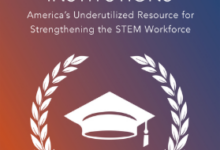Career Technical Education (CTE) aims to equip learners with the skills and industry recognized credentials to obtain high skill, high wage, high demand occupations. For a long time, people have debated whether liberal arts degrees can provide graduates with high skill, high wage, and high demand jobs.
This report from the American Enterprise Institute and Burning Glass Technologies examines job postings and worker resumes to identify high-earning occupations and the specific skills liberal arts students need to obtain to unlock those occupations. The report acknowledges the skills that liberal arts graduates have but emphasizes the importance of obtaining new skills to match the earning potentials of graduates with more technical degrees. The report examines liberal arts graduates’ earning outcomes, identifies a set of ten career sectors and the corresponding occupations and skills needed for liberal arts graduates, and examines the earning potential associated with those sectors.
The report concludes with implications and recommendations for college students, universities and colleges. A critical resource for postsecondary leaders and faculty, this paper provides a roadmap to enhance the liberal arts degree and equip learners with the skills they need for high-wage employment after graduating.







